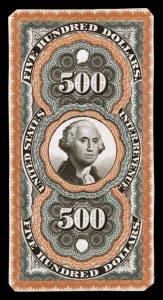Prices and the value of money are difficult to evaluate over time. Readers of Victorian novels know that in the late Nineteenth Century an income of about 150 Pounds a year was the minimum needed to live as a gentleman (Trollope says tartly “an embarrassed gentleman, yes, but a gentleman”). That was three Pounds a week, and for that a person could rent an apartment, eat, and have a part time servant. Before 1900, prices for food and clothing were proportionately much more expensive, and labor was proportionately far cheaper. Sir Walter Scott writes that in his time (1820) one could engage a servant for little more than the food, clothing, and shelter that it cost to maintain them. Still, if a middle class person could live a decent life at three Pounds a week in Victorian England and the Post Office issued a stamp for five Pounds, it would be the equivalent in spending power to a $1,000 stamp today.
This raises the question of what could such stamps possibly be used for. Mainly they were used by banks that sent quantities of cash and gold to one another, and, as such, the high weight and insurance would necessitate high postage. But more importantly, such high value stamps give collectors today a very good idea of why these stamps are so scarce. First, who could possibly have afforded five pounds to put away a mint stamp? And second, how much bullion could possibly have been mailed? But it also helps us understand why we still see the stamps today. After all, the bold design and vivid color, in addition to the huge face value, would make a collector out of anyone who came in contact with one and had an opportunity to save it.
Many collectors complain when the US Post Office issues a $15 or more stamp for overnight service. The face value of these stamps is indeed high. But imagine the feelings of US collectors in 1893 when the Columbian set was issued. With a face value of over $16, this set represented more than the average weekly wage for a working person. It would take a set of nearly $500 face value to do the same thing today.



